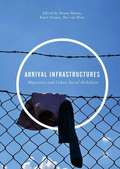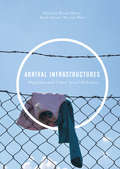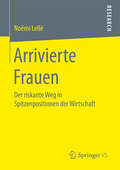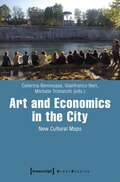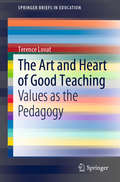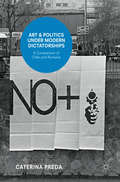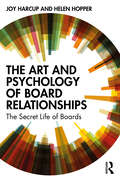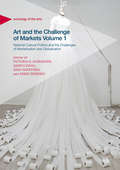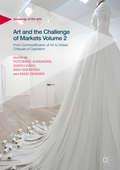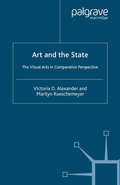- Table View
- List View
Arrival Infrastructures: Urban Social Mobility And Migration
by Bruno Meeus Karel Arnaut Bas Van HeurThis volume introduces a strategic interdisciplinary research agenda on arrival infrastructures. Arrival infrastructures are those parts of the urban fabric within which newcomers become entangled on arrival, and where their future local or translocal social mobilities are produced as much as negotiated. Challenging the dominance of national normativities, temporalities, and geographies of “arrival,” the authors scrutinize the position and potential of cities as transnationally embedded places of arrival. Critically interrogating conceptions of migrant arrival as oriented towards settlement and integration, the volume directs attention to much more diverse migration trajectories that shape our cities today. Each chapter examines how migrants, street-level bureaucrats, local residents, and civil society actors build—with the resources they have at hand—the infrastructures that accommodate, channel, and govern arrival.
Arrival Infrastructures: Migration and Urban Social Mobilities
by Bruno Meeus Karel Arnaut Bas Van HeurThis volume introduces a strategic interdisciplinary research agenda on arrival infrastructures. Arrival infrastructures are those parts of the urban fabric within which newcomers become entangled on arrival, and where their future local or translocal social mobilities are produced as much as negotiated. Challenging the dominance of national normativities, temporalities, and geographies of “arrival,” the authors scrutinize the position and potential of cities as transnationally embedded places of arrival. Critically interrogating conceptions of migrant arrival as oriented towards settlement and integration, the volume directs attention to much more diverse migration trajectories that shape our cities today. Each chapter examines how migrants, street-level bureaucrats, local residents, and civil society actors build—with the resources they have at hand—the infrastructures that accommodate, channel, and govern arrival.
Arrival Infrastructures (PDF): Migration and Urban Social Mobilities
by Bruno Meeus Karel Arnaut Bas Van HeurThis volume introduces a strategic interdisciplinary research agenda on arrival infrastructures. Arrival infrastructures are those parts of the urban fabric within which newcomers become entangled on arrival, and where their future local or translocal social mobilities are produced as much as negotiated. Challenging the dominance of national normativities, temporalities, and geographies of “arrival,” the authors scrutinize the position and potential of cities as transnationally embedded places of arrival. Critically interrogating conceptions of migrant arrival as oriented towards settlement and integration, the volume directs attention to much more diverse migration trajectories that shape our cities today. Each chapter examines how migrants, street-level bureaucrats, local residents, and civil society actors build—with the resources they have at hand—the infrastructures that accommodate, channel, and govern arrival.
Arrivierte Frauen: Der riskante Weg in Spitzenpositionen der Wirtschaft
by Noëmi LelléNoëmi Lellé untersucht das Phänomen der Untervertretung von Frauen im Deutschschweizer Kaderarbeitsmarkt. Die Autorin hält fest, dass umso weniger Frauen auszumachen sind, je höher eine Position ist. Bourdieus Denkwerkzeuge, insbesondere sein Konzept der männlichen Herrschaft (vgl. Bourdieu 2005) bildet die theoretische Grundlage der Analyse und das Forschungsinteresse richtet sich auf den weiblichen Habitus. Geschlecht wird als eine historisch kontingente Art des Seins definiert und Prozesse der Naturalisierung von Geschlecht und Arbeitsteilung der Produktions- und Reproduktionsarbeit werden aufgedeckt. Es wird herausgearbeitet, wie das zweigeschlechtliche Ordnungsprinzip institutionalisiert ist und permanent reziprok reproduziert wird. Diese Ordnung der Gesellschaft wird hier als Geschlechterordnung im Rahmen einer Soziologie des Geschlechts und der Arbeitssoziologie untersucht.
Art and Aesthetics at Work
by A. Carr P. HancockOver the last decade or so, aesthetic and art theory has played an increasingly significant role in the way work and its organization has come to be understood. Bringing together the work of an international spectrum of academics, this collection contributes, in an overall more critical vein, to such emerging debates. Combining both empirical and theoretical material, each chapter re-evaluates the emerging relationship between art, aesthetics and work, exploring its potential as both a medium of critical analysis, and as a site of conflict and resistance.
Art and Creativity in Reggio Emilia: Exploring the Role and Potential of Ateliers in Early Childhood Education (Contesting Early Childhood)
by Vea VecchiThis book explores the contribution of and art and creativity to early education, and examines the role of the atelier (an arts workshop in a school) and atelierista (an educator with an arts background) in the pioneering pre-schools of Reggio Emilia. It does so through the unique experience of Vea Vecchi, one of the first atelieristas to be appointed in Reggio Emilia in 1970. Part memoir, part conversation and part reflection, the book provides a unique insider perspective on the pedagogical work of this extraordinary local project, which continues to be a source of inspiration to early childhood practitioners and policy makers worldwide. Vea’s writing, full of beautiful examples, draws the reader in as she explains the history of the atelier and the evolving role of the atelierista. Key themes of the book include: • processes of learning and knowledge construction • the theory of the hundred languages of childhood and the role of poetic languages • the importance of organisation, ways of working and tools, in particular pedagogical documentation • the vital contribution of the physical environment • the relationship between the atelier, the atelierista, the school and its teachers This enlightening book is essential reading for students, practitioners, policy makers and researchers in early childhood education, and also for all those in other fields of education interested in the relationship between the arts and learning.
Art and Creativity in Reggio Emilia: Exploring the Role and Potential of Ateliers in Early Childhood Education (Contesting Early Childhood)
by Vea VecchiThis book explores the contribution of and art and creativity to early education, and examines the role of the atelier (an arts workshop in a school) and atelierista (an educator with an arts background) in the pioneering pre-schools of Reggio Emilia. It does so through the unique experience of Vea Vecchi, one of the first atelieristas to be appointed in Reggio Emilia in 1970. Part memoir, part conversation and part reflection, the book provides a unique insider perspective on the pedagogical work of this extraordinary local project, which continues to be a source of inspiration to early childhood practitioners and policy makers worldwide. Vea’s writing, full of beautiful examples, draws the reader in as she explains the history of the atelier and the evolving role of the atelierista. Key themes of the book include: • processes of learning and knowledge construction • the theory of the hundred languages of childhood and the role of poetic languages • the importance of organisation, ways of working and tools, in particular pedagogical documentation • the vital contribution of the physical environment • the relationship between the atelier, the atelierista, the school and its teachers This enlightening book is essential reading for students, practitioners, policy makers and researchers in early childhood education, and also for all those in other fields of education interested in the relationship between the arts and learning.
Art and Culture in the Multiverse of Metaverses: Immersion, Presence, and Interactivity in the Digital Age (Springer Series on Cultural Computing)
by James HutsonDrawing on the art historical framing of Location, Place, and Identity, this book will examine how the factors of Immersion, Presence, and Interactivity of XR are shaping our understanding of the world and our place within it. Location refers to the specific geographical or spatial context in which a work of art is created or experienced. Place refers to the social, cultural, and historical context of that location. Identity refers to the ways in which individuals and communities construct and express their sense of self and belonging within those contexts. Through case studies and theoretical analysis, Art and Culture in the Multiverse of Metaverses - Immersion, Presence, and Interactivity in the Digital Age, will explore how the factors of Immersion, Presence, and Interactivity of XR can be aligned with these art historical concepts, providing new opportunities for understanding and engaging with Location, Place, and Identity. For example, XR can be used to create immersive experiences of historical locations and cultural sites, allowing users to explore and engage with them in ways that would otherwise be impossible. Additionally, XR can be used to create interactive artworks that engage with issues of identity and belonging, creating new possibilities for self-expression and exploration.
Art and Disability: The Social and Political Struggles Facing Education
by A. WexlerWexler argues that the arts are most effective when they are in service of social growth, critical to identity formation. This book balances theory with practical knowledge and offers critical research that challenges the biases regarding the nature of art and education.
Art and Economics in the City: New Cultural Maps (Urban Studies)
by Caterina Benincasa Gianfranco Neri Michele TrimarchiEmerging forms of alternative economic frameworks are changing the structure of society, redefining the relationship between centre and periphery, and the social dynamics in the urban fabric. In this context, the arts can play a crucial role in formulating a concept of complex and plural citizenship: This economic, social and cultural paradigm has the potential to overcome the conventional isolation of the arts and culture in ivory towers, and thereby to gradually make the urban fabric more fertile. This volume faces such sensitive issues by collating contributions from various disciplines: Economists, sociologists, urbanists, architects and creative artists offer a broad and deep assessment of urban dynamics and their visions for the years to come.
Art and Enchantment: How Wonder Works (Contemporary Liminality)
by Patrick CurryThis book concerns the experience of enchantment in art. Considering the essential characteristics, dynamics and conditions of the experience of enchantment in relation to art, including liminality, it offers studies of different kinds of artistic experience and activity, including painting, music, fiction and poetry, before exploring the possibility of a life oriented to enchantment as the activity of art itself. With attention to the complex relationship between wonder in art and the programmatic disenchantment to which it is often subject, the author draws on the thought of a diverse range of philosophers, sociological theorists and artists, to offer an understanding of art through the idea of enchantment, and enchantment through art. An accessible study, richly illustrated with experience – both that of the author and others – Art and Enchantment will appeal to scholars and students of sociology, anthropology, philosophy, and anyone with interests in the nature of aesthetic experience.
Art and Enchantment: How Wonder Works (Contemporary Liminality)
by Patrick CurryThis book concerns the experience of enchantment in art. Considering the essential characteristics, dynamics and conditions of the experience of enchantment in relation to art, including liminality, it offers studies of different kinds of artistic experience and activity, including painting, music, fiction and poetry, before exploring the possibility of a life oriented to enchantment as the activity of art itself. With attention to the complex relationship between wonder in art and the programmatic disenchantment to which it is often subject, the author draws on the thought of a diverse range of philosophers, sociological theorists and artists, to offer an understanding of art through the idea of enchantment, and enchantment through art. An accessible study, richly illustrated with experience – both that of the author and others – Art and Enchantment will appeal to scholars and students of sociology, anthropology, philosophy, and anyone with interests in the nature of aesthetic experience.
The Art and Heart of Good Teaching: Values as the Pedagogy (SpringerBriefs in Education)
by Terence LovatThis book summarizes and updates findings from the Australian Values Education Program with a focus on the latest international research in the field, both theoretical and practice-based. Further, it provides a theoretical and practical basis for understanding the disenchantment with low-level accountability approaches to learning (e.g. NAPLAN in Australia). In turn, the book demonstrates the effectiveness of Values Education as a holistic pedagogy with the potential to enhance students’ learning effects in terms of their personal, social, emotional and academic development. It offers well-tested alternative pedagogical approaches, based on research insights largely originating from actual classroom-based practice.
Art and Politics under Modern Dictatorships: A Comparison of Chile and Romania
by Caterina PredaThis book analyzes the relationship between art and politics in two contrasting modern dictatorships. Through a detailed look at the Chilean and Romanian dictatorships, it compares the different ways in which political regimes convey their view of the world through artistic means. It examines how artists help \ convey a new understanding of politics and political action during repressive regimes that are inspired by either communism or anti-communism (neoliberalism, traditionalist, conservative). This book demonstrates how artistic renderings of life during dictatorships are similar in more than one respect, and how art can help better grasp the similarities of these regimes. It reveals how dictatorships use art to symbolically construct their power, which artists can consolidate by lending their support, or deconstruct through different forms of artistic resistance.
Art and Politics under Modern Dictatorships: A Comparison of Chile and Romania
by Caterina PredaThis book analyzes the relationship between art and politics in two contrasting modern dictatorships. Through a detailed look at the Chilean and Romanian dictatorships, it compares the different ways in which political regimes convey their view of the world through artistic means. It examines how artists help \ convey a new understanding of politics and political action during repressive regimes that are inspired by either communism or anti-communism (neoliberalism, traditionalist, conservative). This book demonstrates how artistic renderings of life during dictatorships are similar in more than one respect, and how art can help better grasp the similarities of these regimes. It reveals how dictatorships use art to symbolically construct their power, which artists can consolidate by lending their support, or deconstruct through different forms of artistic resistance.
The Art and Psychology of Board Relationships: The Secret Life of Boards
by Joy Harcup Helen HopperThe relationships within boards can make or break an organisation, but well-functioning relationships take skill and effort to maintain. This book looks at the psychology behind individual and group behaviour and offers tactics and power tools to help make a success of your board career. The book shares advice and practical tips from 40 experienced board members from the worlds of corporates, the public sector and charities on how to spot and manage complex dynamics. And each chapter ends with techniques for unlocking tricky board relationships that you can put into practice immediately. The authors examine case studies and explore topics such as psychodynamics, cognitive behavioural psychology and neuroscience for insights into how boards react under pressure. They then demonstrate how to practise the ART of managing board relationships by increasing Awareness, Relating constructively to others, and choosing Tactics to ease tensions and foster collaboration. The Art and Psychology of Board Relationships: The Secret Life of Boards reveals why board relationships lie at the heart of organisational success – and how you can use them to gain competitive edge. It is essential reading for current and aspiring board members, coaches, facilitators and anyone with an interest in boardroom dynamics.
The Art and Psychology of Board Relationships: The Secret Life of Boards
by Joy Harcup Helen HopperThe relationships within boards can make or break an organisation, but well-functioning relationships take skill and effort to maintain. This book looks at the psychology behind individual and group behaviour and offers tactics and power tools to help make a success of your board career. The book shares advice and practical tips from 40 experienced board members from the worlds of corporates, the public sector and charities on how to spot and manage complex dynamics. And each chapter ends with techniques for unlocking tricky board relationships that you can put into practice immediately. The authors examine case studies and explore topics such as psychodynamics, cognitive behavioural psychology and neuroscience for insights into how boards react under pressure. They then demonstrate how to practise the ART of managing board relationships by increasing Awareness, Relating constructively to others, and choosing Tactics to ease tensions and foster collaboration. The Art and Psychology of Board Relationships: The Secret Life of Boards reveals why board relationships lie at the heart of organisational success – and how you can use them to gain competitive edge. It is essential reading for current and aspiring board members, coaches, facilitators and anyone with an interest in boardroom dynamics.
The Art and Science of 3D Audio Recording
by Edwin Pfanzagl-CardoneThis professional book offers a unique, comprehensive and timely guide on 3D audio recording. Intended for sound engineers and professionals, and summarizing more than twenty-year research on this topic, it includes extensive information and details on various microphone techniques and loudspeaker layouts, such as Auro-3D®, Dolby® AtmosTM, DTS:X®, MMAD, SONY 360 Reality Audio and Ambisonics. It presents a rich set of results obtained from both objective measurements and subjective listening tests, and a number of case studies for 3D recording, ranging from solo-instrument techniques to full symphony orchestra, and microphone systems for virtual reality applications. Further, it includes a chapter on spatial hearing discussing issues of 3D audio sound reproduction. All in all, this book offers extensive, practical information for sound engineers and professionals.
The Art and Science of Connection: Why Social Health is the Missing Key to Living Longer, Healthier, and Happier
by Kasley KillamA groundbreaking redefinition of what it means to be healthy that introduces the need for social health - the part of wellbeing that comes from feeling connected - to truly flourish.Exercise. Eat a balanced diet. Go to therapy. Most wellness advice is focused on achieving and maintaining good physical and mental health. But Harvard-trained social scientist and pioneering social health expert Kasley Killam reveals that this approach is missing a vital component: human connection.Relationships not only make us happier, but also are critical to our overall health and longevity. Research shows that people with a strong sense of belonging are 2.6 times more likely to report good or excellent health. Perhaps even more astonishingly, people who lack social support are up to 53% more likely to die from any cause. Yet social health has been overlooked and underappreciated - until now.Just as we exercise our physical muscles, we can strengthen our social muscles. Weaving together cutting-edge science, mindset shifts, and practical wisdom, Killam offers the first methodology for how to be socially healthy. An antidote to the loneliness epidemic and an inspiring manifesto for seeing wellbeing as not only physical and mental, but also social, The Art and Science of Connection is a handbook for thriving.In this essential book, you will:- Learn a simple yet powerful framework to understand, evaluate, and bolster your social health.- Discover the exact strategy or habit you need, as well as research-backed tips, to cultivate and sustain meaningful connection now and throughout your life.- Glean actionable insights to develop a sense of community in your neighbourhood, at work, and online from a spirited group of neighbours in Paris, the CEO of a major healthcare company, and an artificially intelligent chatbot.- Get an insider look at the innovative ways that doctors, teachers, entrepreneurs, architects, government leaders, and everyday people are catalysing a movement toward a more socially healthy society.The Art and Science of Connection will transform the way you think about each interaction with a friend, family member, coworker, or neighbour, and give you the tools you need to live a more connected and healthy life - whether you are an introvert or extrovert, if you feel stretched thin, and no matter your age or background. Along the way, Killam will reveal how a university student, a newlywed, a working professional, and a retired widow overcame challenges to thrive through connection-and how you can, too.
The Art and Science of Demand and Supply Chain Planning in Today's Complex Global Economy
by Paul MyersonThe demand and supply chain planning process for manufacturers, distributors, and retailers has evolved over the years. It has gone from a disjointed, unconnected, slow, inaccurate, fairly manual set of processes to an integrated, timely process enabled by the use and coordination of highly trained people, lean, agile processes, and cutting-edge technology. To make this set of processes work effectively, one has to fully understand and appreciate that there is an "art and science" aspect to the process which can take years of education and experience to fully understand. Essentially, this book will offer the reader a chance to fully understand the interconnected set of processes in a "best-practice" application. Furthermore, examples and cases will be used to illustrate its practical application in today’s complex global supply chain. In addition, readers will understand and be able to apply and articulate the concepts, tools, and techniques used in the efficient supply of goods and services in today’s changing global economy. It will help them to learn how businesses, through their supply chain, work both internally and with their trading partners – both upstream and downstream – to build strong relationships and integrate demand and supply planning activities across the supply chain to deliver customer value efficiently and effectively. They will learn about the tools and technologies enabling integration, and the critical drivers and key metrics of supply chain performance.
The Art and Science of Demand and Supply Chain Planning in Today's Complex Global Economy
by Paul MyersonThe demand and supply chain planning process for manufacturers, distributors, and retailers has evolved over the years. It has gone from a disjointed, unconnected, slow, inaccurate, fairly manual set of processes to an integrated, timely process enabled by the use and coordination of highly trained people, lean, agile processes, and cutting-edge technology. To make this set of processes work effectively, one has to fully understand and appreciate that there is an "art and science" aspect to the process which can take years of education and experience to fully understand. Essentially, this book will offer the reader a chance to fully understand the interconnected set of processes in a "best-practice" application. Furthermore, examples and cases will be used to illustrate its practical application in today’s complex global supply chain. In addition, readers will understand and be able to apply and articulate the concepts, tools, and techniques used in the efficient supply of goods and services in today’s changing global economy. It will help them to learn how businesses, through their supply chain, work both internally and with their trading partners – both upstream and downstream – to build strong relationships and integrate demand and supply planning activities across the supply chain to deliver customer value efficiently and effectively. They will learn about the tools and technologies enabling integration, and the critical drivers and key metrics of supply chain performance.
Art and Soul: Rudolf Steiner, Interdisciplinary Art and Education (Landscapes: the Arts, Aesthetics, and Education #25)
by Victoria De RijkeThis book brings together Steiner's philosophical, biodynamic and cultural contributions to education, where 'spirit' and ‘soul’ are the creative elements in human evolution. His thought is applied to selected examples of innovative artistic practice and pedagogy of the present. This volume is intended for researchers in the arts and education with an interest in Rudolf Steiner's huge influence on educational thought and policy.This is an urgent point in time to reflect on the role of arts in education and what it might mean for our souls. An accessible yet scholarly study of interdisciplinarity, imagination and creativity is of critical widespread interest now, when arts education in many countries is threatened with near-extinction.
Art and the Challenge of Markets Volume 1: National Cultural Politics and the Challenges of Marketization and Globalization (Sociology of the Arts)
by Victoria D. Alexander Samuli Hägg Simo Häyrynen Erkki SevänenArt and the Challenge of Markets Volumes 1 & 2 examine the politics of art and culture in light of the profound changes that have taken place in the world order since the 1980s and 1990s. The contributors explore how in these two decades, the neoliberal or market-based model of capitalism started to spread from the economic realm to other areas of society. As a result, many aspects of contemporary Western societies increasingly function in the same way as the private enterprise sector under traditional market capitalism. The first volume of this two-volume collection considers a broad range of national cultural policies from European and North American countries, and examines the strengthening of international and transnational art worlds in music, visual arts, film, and television. The chapters cover cultural policy and political culture in the United States, United Kingdom, Germany, France, Switzerland, the Nordic countries, the Balkans, and Slovenia, and address the extent to which Western nations have shifted from welfare-state to market-based ideologies. Tensions between centres and peripheries in global art worlds are considered, as well as complex interactions between nations and international and transnational art worlds, and regional variations in the audiovisual market. Both volumes provide students and scholars across a range of disciplines with an incisive, comparative overview of the politics of art and culture and national, international and transnational art worlds in contemporary capitalism.
Art and the Challenge of Markets Volume 2: From Commodification of Art to Artistic Critiques of Capitalism (Sociology of the Arts)
by Victoria D. Alexander Samuli Hägg Simo Häyrynen Erkki SevänenArt and the Challenge of Markets Volumes 1 & 2 examine the politics of art and culture in light of the profound changes that have taken place in the world order since the 1980s and 1990s. The contributors explore how in these two decades, the neoliberal or market-based model of capitalism started to spread from the economic realm to other areas of society. As a result, many aspects of contemporary Western societies increasingly function in the same way as the private enterprise sector under traditional market capitalism.This second volume analyses the relationships of art with contemporary capitalist economies and instrumentalist cultural policies, and examines several varieties of capitalist-critical and alternative art forms that exist in today’s art worlds. It also addresses the vexed issues of art controversies and censorship. The chapters cover issues such as the culturalization of the economy, aesthetics and anti-aesthetics, the societal benefits of works of art, art's responsibility to society, "artivism", activist arts as protest and capitalism-critical works, and controversies over nudity in art, as well as considering the marketisation of emerging visual arts worlds in East Asia. The book ends with the a concluding chapter suggesting that even in today's marketized and commercialized environments, art will find a way. Both volumes provide students and scholars across a range of disciplines with an incisive, comparative overview of the politics of art and culture and national, international and transnational art worlds in contemporary capitalism.
Art and the State: The Visual Arts in Comparative Perspective (St Antony's Series)
by V. Alexander M. RueschemeyerThis book examines the impact of states and their policies on visual art. States shape the role of art and artists in society, influence the development of audiences, support artistic work, and even affect the very nature of artistic production. The book contrasts developments in the United States with art policies in Britain and in the social democratic states of Norway and Sweden. In addition, it analyzes revealing transitions - the changes brought about in East Germany after unification and the experiences of artists who left the Soviet Union for the west. The result is a significant contribution to the sociology and the political economy of art.
